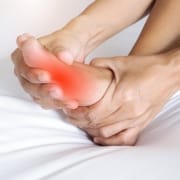Does a Pinched Toe Mean I Have Hammertoe?
Pinched toes are a relatively common occurrence, and they can usually be traced back to shoes that compress the toes together. If you’re wondering if your pinched toe means you have hammertoe in Austin, TX, we’ll look at the facts of the disorder and when you should see a podiatrist.
Symptoms of Hammertoe
A pinched toe may mean that you have hammertoe, a condition where the middle toe joint starts to bend upwards. The more your toes rub together in ill-fitting shoes, the more likely you’ll begin to feel discomfort or develop corns to protect them from one another.
What Else Causes Pinched Toes?
Foot deformities or disorders, such as bunions, bone growths, or inflamed tissues, can also cause pinched toes. Anything that puts pressure on your nerves or bones can lead to a joint malformation.
Will Pinched Toes Heal on Their Own?
It depends on the severity of the joint bend. Mild cases may be fixed with little more than rest, gentle stretching, and a change in footwear. However, if you don’t notice an improvement after a few days or even a week, it’s time to see a podiatrist in Austin, TX.
A podiatrist may be able to help you strengthen the foot, whether it’s with an orthotic device or with physical therapy exercises. You may need to buy new shoes with a broader toe box, or wear pads or separators so your toes don’t rub together with every step.
Relief for Pinched Toes
It’s not always easy to understand foot problems, particularly if you haven’t been doing anything out of the ordinary. However, as tempting as it may be to hope that your pinched toe goes away on its own, more moderate cases may need expert intervention. Otherwise, you’re more likely to run into the same problem again and again.
At the offices of Dr. Jeffrey Lamour, DPM, PA, we can help you not only diagnose the problem, but find natural, long-lasting relief so you can trust your feet to carry you for many years to come.








